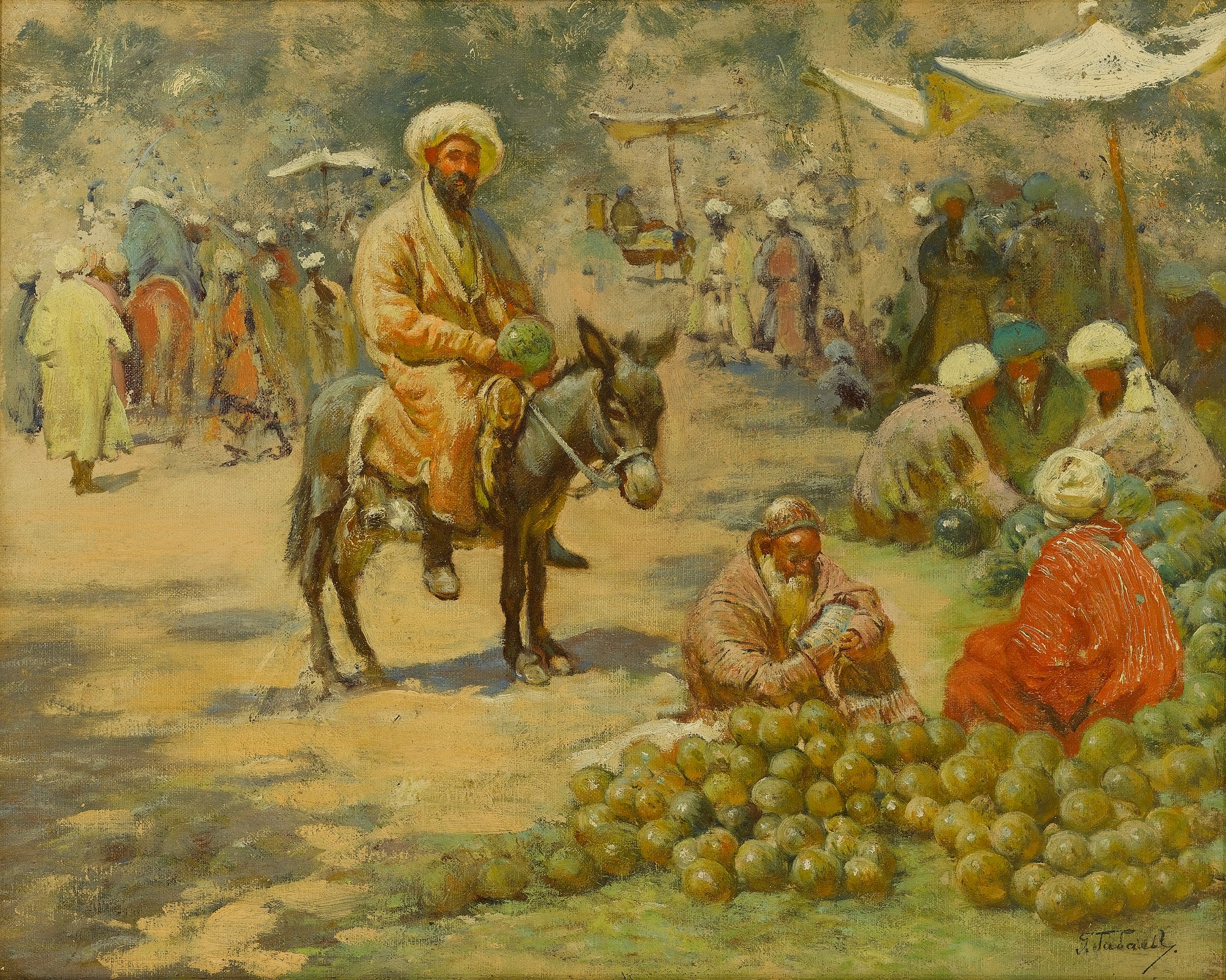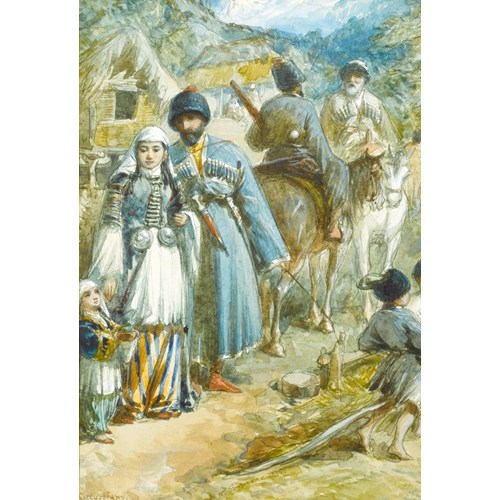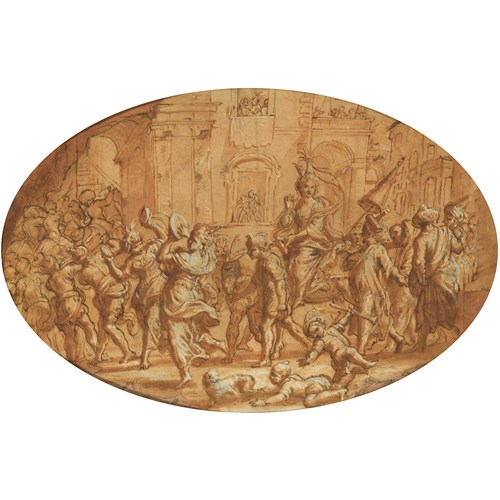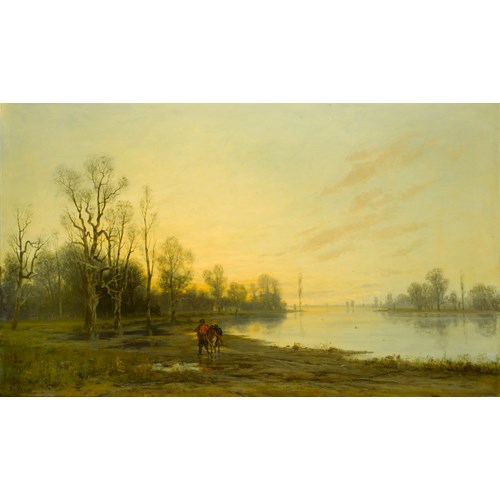Marketplace
The Market
Giorgy Ivanovich (Gigo) Gabashvili
The Market
Epoque 1850-1900, 19th century, 20th century
Origine Georgia
Medium Oil on board
Dimension 32.5 x 40.5 cm (12³/₄ x 16 inches)
The soft, delicate palette used in The Market emphasises the poignant solitude of the man and donkey amidst the commotion and conversation found in the marketplace. Centrally placed in the composition and set back from the main activity, the man, who is clearly oversized for his loyal donkey, cradles a single melon in his hand. The man faces the viewer directly, his beard long and black, with a voluminous cream turban is wrapped around his head. To his right, seated on the floor, several men huddle together and guard piles of melons and other fruits that are available for sale. In the background, the smoky outline of market activity takes place under a grouping of white canvas umbrellas, the occasional visible white turban and coloured kaftan hinting at the Oriental setting of The Market.
In 1894, Gigo Gabashvili travelled around Central Asia seeking new sources of inspiration for his work. Undoubtedly The Market was painted either in situ during this visit, or on his return to Georgia. During his time in Central Asia, and particularly in Uzbekistan, Gabashvili completed a number of sketches and studies to encapsulate the local populace and culture. Some of these preliminary drawings culminated in Bazaar in Samarkand, one of four versions he painted of this famous market in front of the Sher-Dor Madrasah in the Registan Square of the city. The American diplomat and businessman Charles R. Crane, whom Gabashvili had previously met in Tiflis, commissioned him to produce a series of paintings of Bukhara and Samarkand. One of these works, Gabashvili’s 1885 version of the Bazaar in Samarkand, was sold for $1.36 million at Christie’s in 2006.
Gabashvili, who also painted under the pseudonym Gigo Gabaev, is widely considered to be the founder of the new Critical Realism School of painting in Georgian art. He was born in Tiflis in 1862 and like many other aspiring Georgian artists in the nineteenth century, went to St. Petersburg to study at the prestigious Academy of Arts. His first entry attempt in 1883 was unsuccessful and he returned to Tiflis where he became Frants Alekseevich Roubaud’s assistant. As Roubaud’s assistant, Gabashvili travelled extensively gathering materials and studies for a series of paintings depicting scenes from the recent Russian-Turkish war of 1877-78. With a glowing recommendation from his mentor, Gabashvili was accepted into the St. Petersburg Academy of Arts, in 1886, where he won several accolades.
Gabashvili was well acquainted with and influenced by The Wanderers, particularly Ilya Yefimovich Repin, and is frequently cited as the first Georgian Realist painter as he sought to convey a wide range of subjects, in oil and watercolour, including portraits, landscapes and scenes from everyday life. He is best known for his series of vivid portraits depicting peasants, townsmen and noblemen, for example The Three Townsmen (1893; National Georgian Museum, Tbilisi.) He continued his studies in Munich until 1897, after which he returned to Tiflis and devoted the latter part of his life to teaching, and founded an art studio. From 1900, he taught at the school of drawing at the Caucasian Society for the Promotion of the Arts, where he later became director. From 1922 to 1930 Gabashvili was the head of the art studio at the Academy of Art in Tbilisi
In 1894, Gigo Gabashvili travelled around Central Asia seeking new sources of inspiration for his work. Undoubtedly The Market was painted either in situ during this visit, or on his return to Georgia. During his time in Central Asia, and particularly in Uzbekistan, Gabashvili completed a number of sketches and studies to encapsulate the local populace and culture. Some of these preliminary drawings culminated in Bazaar in Samarkand, one of four versions he painted of this famous market in front of the Sher-Dor Madrasah in the Registan Square of the city. The American diplomat and businessman Charles R. Crane, whom Gabashvili had previously met in Tiflis, commissioned him to produce a series of paintings of Bukhara and Samarkand. One of these works, Gabashvili’s 1885 version of the Bazaar in Samarkand, was sold for $1.36 million at Christie’s in 2006.
Gabashvili, who also painted under the pseudonym Gigo Gabaev, is widely considered to be the founder of the new Critical Realism School of painting in Georgian art. He was born in Tiflis in 1862 and like many other aspiring Georgian artists in the nineteenth century, went to St. Petersburg to study at the prestigious Academy of Arts. His first entry attempt in 1883 was unsuccessful and he returned to Tiflis where he became Frants Alekseevich Roubaud’s assistant. As Roubaud’s assistant, Gabashvili travelled extensively gathering materials and studies for a series of paintings depicting scenes from the recent Russian-Turkish war of 1877-78. With a glowing recommendation from his mentor, Gabashvili was accepted into the St. Petersburg Academy of Arts, in 1886, where he won several accolades.
Gabashvili was well acquainted with and influenced by The Wanderers, particularly Ilya Yefimovich Repin, and is frequently cited as the first Georgian Realist painter as he sought to convey a wide range of subjects, in oil and watercolour, including portraits, landscapes and scenes from everyday life. He is best known for his series of vivid portraits depicting peasants, townsmen and noblemen, for example The Three Townsmen (1893; National Georgian Museum, Tbilisi.) He continued his studies in Munich until 1897, after which he returned to Tiflis and devoted the latter part of his life to teaching, and founded an art studio. From 1900, he taught at the school of drawing at the Caucasian Society for the Promotion of the Arts, where he later became director. From 1922 to 1930 Gabashvili was the head of the art studio at the Academy of Art in Tbilisi
Epoque: 1850-1900, 19th century, 20th century
Origine: Georgia
Medium: Oil on board
Signature: Signed in Cyrillic (lower right).
Dimension: 32.5 x 40.5 cm (12³/₄ x 16 inches)
Plus d'œuvres d'art de la Galerie









